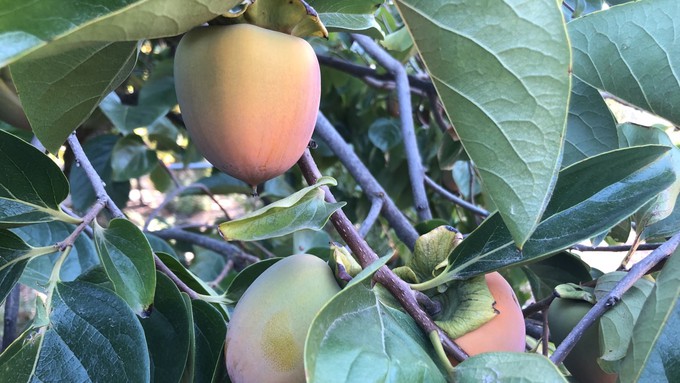
Pleasant (but still warm) days ahead – great for fall planting

Persimmons are ripening in the warm fall weather. Kathy Morrison
Summer is over (really, we mean it!), but warmer than average days continue to linger.
According to the National Weather Service, “Area temperatures have been warm this month so far, both highs and lows. Persistent high pressure has been the cause. Redding Airport has even seen three days when the high reached 100 degrees, the 8th, 12th and 13th.”
Sacramento didn’t get quite that hot, topping out at 95 degrees on Oct. 7 and 8. Normal for October is 78 degrees. As the weather service noted, overnight lows have been relatively warm, too, staying mostly in the high 50s; normal is 50.
The forecast for the week ahead will feel more like fall – at least for starters. Sunday and Monday are expected to be just about average (76 and 77 are the respective forecast highs). Then, the weather service predicts another little spike in heat, back up to 88 on Wednesday, before settling down to the low 80s/high 70s by next weekend. Meanwhile, overnight lows will remain above average, hovering around 55 degrees. This week is expected to remain dry with still no precipitation in sight.
All this warmth makes for great planting weather. Cool-season crops will get off to a fast start.
* This is the best time to plant trees, shrubs and perennials in Sacramento. Add a little well-aged compost and bone meal to the planting hole, but hold off on other fertilizers until spring. Keep the transplants well-watered (but not wet) for the first month as they become settled.
* Now is the time to plant seeds for many flowers directly into the garden, including cornflower, nasturtium, nigella, poppy, portulaca, sweet pea and stock.
* Plant seeds for radishes, bok choy, mustard, spinach and peas.
* Plant garlic and onions.
* Set out cool-weather bedding plants, including calendula, pansy, snapdragon, primrose and viola.
* Reseed and feed the lawn, if you still have one. Work on bare spots.
* Dig up corms and tubers of gladioluses, dahlias and tuberous begonias after the foliage dies. Clean and store in a cool, dry place.
* Treat azaleas, gardenias and camellias with chelated iron if leaves are yellowing between the veins.
* Clean up the summer vegetable garden and compost disease-free foliage.
* Harvest pumpkins and winter squash.
Comments
0 comments have been posted.Sacramento Digs Gardening to your inbox.
Sites We Like
Garden Checklist for week of April 21
This week there’s plenty to keep gardeners busy. With no rain in the immediate forecast, remember to irrigate any new transplants.
* Weed, weed, weed! Get them before they flower and go to seed.
* April is the last chance to plant citrus trees such as dwarf orange, lemon and kumquat. These trees also look good in landscaping and provide fresh fruit in winter.
* Smell orange blossoms? Feed citrus trees with a low dose of balanced fertilizer (such as 10-10-10) during bloom to help set fruit. Keep an eye out for ants.
* Apply slow-release fertilizer to the lawn.
* Thoroughly clean debris from the bottom of outdoor ponds or fountains.
* Spring brings a flush of rapid growth, and that means your garden is really hungry. Feed shrubs and trees with a slow-release fertilizer. Or mulch with a 1-inch layer of compost.
* Azaleas and camellias looking a little yellow? If leaves are turning yellow between the veins, give them a boost with chelated iron.
* Trim dead flowers but not leaves from spring-flowering bulbs such as daffodils and tulips. Those leaves gather energy to create next year's flowers. Also, give the bulbs a fertilizer boost after bloom.
* Pinch chrysanthemums back to 12 inches for fall flowers. Cut old stems to the ground.
* Mulch around plants to conserve moisture and control weeds.
* From seed, plant beans, beets, cantaloupes, carrots, corn, cucumbers, melons, radishes and squash.
* Plant onion sets.
* In the flower garden, plant seeds for asters, cosmos, celosia, marigolds, salvia, sunflowers and zinnias.
* Transplant petunias, zinnias, geraniums and other summer bloomers.
* Plant perennials and dahlia tubers for summer bloom.
* Mid to late April is about the last chance to plant summer bulbs, such as gladiolus and tuberous begonias.
* Transplant lettuce seedlings. Choose varieties that mature quickly such as loose leaf.